Author(s): Jos P Noordhuizen
Respiratory health in sporting horses is primordial for optimal general health and their performance. The respiratory health is influenced by many intrinsic factors as well as environmental factors. Heat stress conditions and poor barn-related factors are examples of situations where-in the horse shows signs of impaired respiratory health. Forest fires are another example of an aggravation of an impaired respiratory health. Major risk factors of forest fires are the heat of the fire itself, the smoke, and the fine particles in the smoke. Fine particles may enter deeply into the lungs and cause pneumonia and cell destruction. In this paper are addressed the basic respiratory health of a horse, the risk factors affecting this health, the signs and evolution of respiratory distress, the latter especially affected by forest fires. Finally, a comparison is made between respiratory health problems in man and horse, caused by effects of forest fires.
Respiratory health in horses, and more specifically in sporting horses, is primordial for a good general health state as well as for their performance. The same is valid for top athletes in the human population [1-5]. A disturbed respiratory health has a great negative impact on the horse’s functioning because the oxygen exchange in the lungs is poor, and the immune responsiveness is most often decreased [1]. Respiratory health can be influenced by different factors such as general health status of the animal, the barn climate quality, the management quality, the occurrence of heat stress, the outside air quality and many others [6].
Horses are ‘’nose-breathers’’ and they eat their feed from the ground with their head down. When the respiratory tract is obstructed, the horse can hardly breath. A poor barn climate quality hampers the horse to get physiologically rid of dust, particles, spores, and micro-organisms from their respiratory system [3, 4]. Generally spoken the same applies to human beings [7, 8]. Forest fires occur frequently in many countries worldwide as is shown by NASA Terra Satellite maps [9]. Some of these fires have a natural occurrence. For example, in Canada they are related to natural cycles of rainfall, dryness, and lightning in summer. Many other fires are mainly due to human activity either accidently or on purpose. The latter is to try to get rid of natural vegetation from farmland and pastures in a controlled way. Sometimes forest fires have a criminal origin. Fires can generate large amounts of smoke pollution and greenhouse gases [9].
The objectives of this article are to define respiratory health in horses, present the main signs and the evolution of respiratory distress, specifically caused by forest fires. A comparison with effects of the forenamed in man is made.
Respiratory health is the physiological function of the body for exchanging air (oxygen) which on its turn is influenced by genetics, body conformation, general health status and environmental factors. A standard respiration rate of horses in rest is between 8 and 12 beats per minute (BPM). At this level of BPM, about 72 L of air is entering and exiting every minute. Above 30 BPM there is surely a respiratory problem. Air quality plays a paramount role here.
Air quality concerns for example the air pollution levels, pollen concentration, mold spore concentration, chemical pollution, airborne particles (10). Fig. 1 gives an impression of factors involved in poor air quality [1]. Apparently, good ventilation of the barn is the way to get rid of most of them.

Figure 1: Overview of different factors affecting air quality negatively [1]
The U.S. Environment Protection Agency has developed an Air Quality Index (AQI) which takes several of such parameters into account [10]. EPA has an enormous worldwide network of cooperating institutions [5]. Fig. 2 presents an ‘’easy to read’’ info-graph on AQI [10].
It is generally accepted that, at an AQI of 300 and more, horses and man are at high risk of respiratory and/or general health problems. Individual biological differences among horses (and among men) makes it possible that even at lower AQI-levels some individuals are already severely affected (see the blue triangle in Fig. 2).
Among other environmental factors impacting on the respiratory health negatively are the barn climate conditions, the outside air quality conditions (e.g. heat stress), feed quality, drinking water quality, management quality features. When one or more of the forenamed factors are not optimal, the basic respiratory health of horses is impaired. Those horses will be more sensitive to heat stress, but also to other stressors such as caused by forest fires [1].
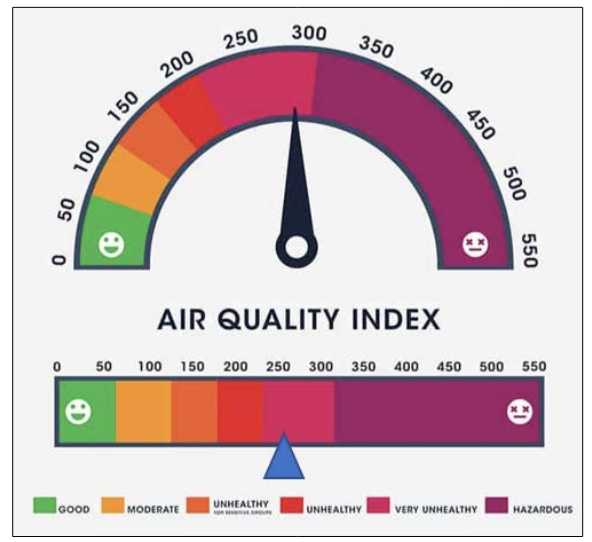
Figure 2: The Info-graphic of Air Quality Index (AQI). The blue triangle indicates the mean upper critical value for horses and most men [10]
Table 1 provides an overview of different barn parameters associated with the basic respiratory health of horses. Most of the parameters in Table 1 will, when deviating from the standard, indicate a poor barn ventilation and other failures in barn management [1-4].
Signs of an impaired basic respiratory health are listed in Table 2. These signs do not only occur at an impaired basic respiratory health; they may also be observed when the horse is in pain, under heat stress conditions, or other stress conditions (e.g. social stress; forest fire stress).
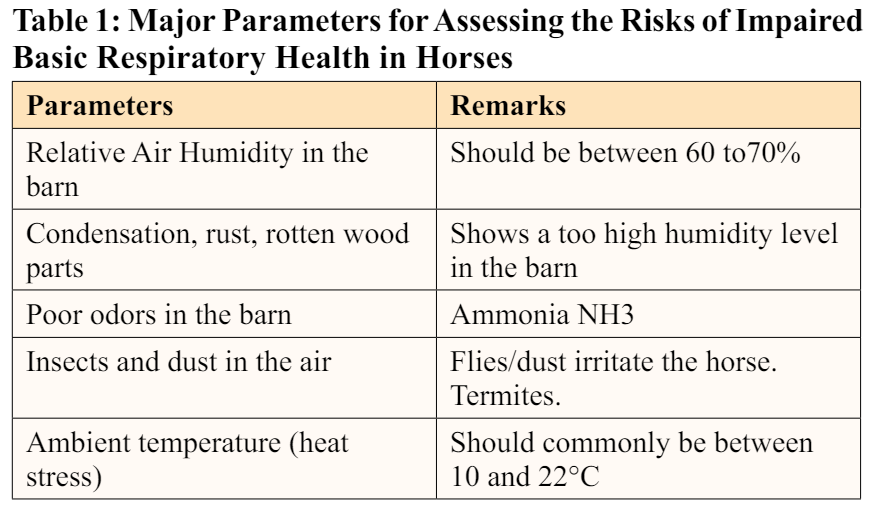
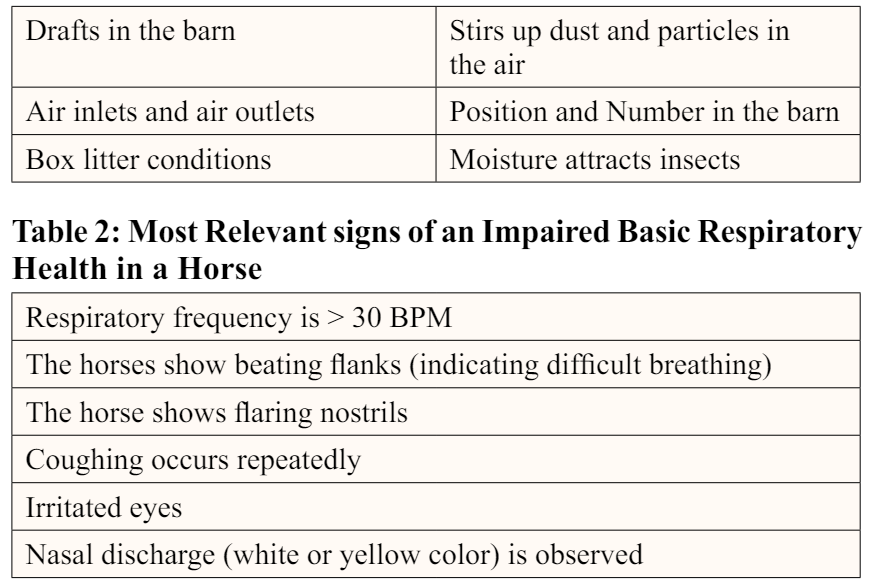
The signs of an impaired basic respiratory health in horses listed in Table 2 are roughly the same as in man. The most important factors contributing to an impaired respiratory health in man are listed in Table 3. These factors can roughly be compared to the parameters in horses as listed in Table 1. Factors different from those in horses are, for example, tobacco use, social status, educational level, old age, body weight (obese) and body size, chronic lung and cardiac problems, chest pain [7].
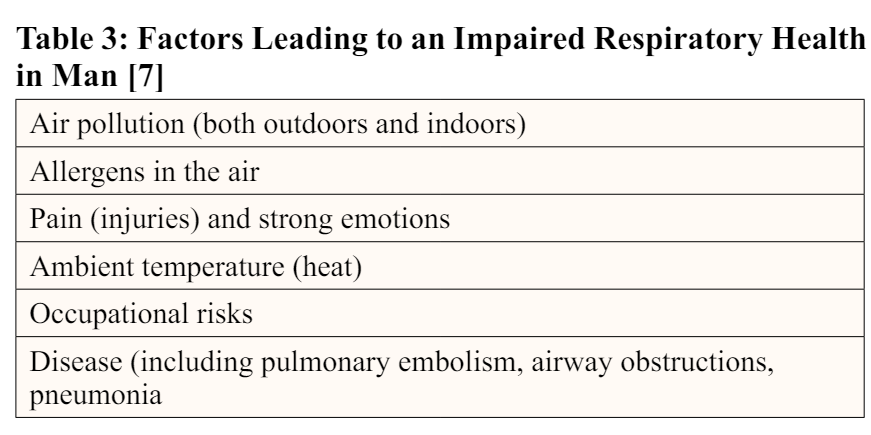
Forest fires occur due to lightning, accidently by people, or by controlled burning of vegetation to manage farmland and pasture. During such fires different substances become airborne, specifically through the smoke. The composition of smoke is determined by the different types of wood, vegetables, plastics, house materials, and other combustibles involved. All these materials produce different compounds when burned [5, 11]. The greatest health threat for man originating from smoke is the volume of fine particles entering deeply into the lungs [10].
Table 4 presents an overview of risk conditions for the (respiratory) health of horses and man associated with forest fires.
The major problems are caused by the liquid particle droplets and the solid particles in the smoke. Especially the solid particles entering deeply into the lung represent a high health risk. Moreover, the fire ashes can also be irritating the skin, nose, and throat in man, often causing nose bleeding and more frequent coughing
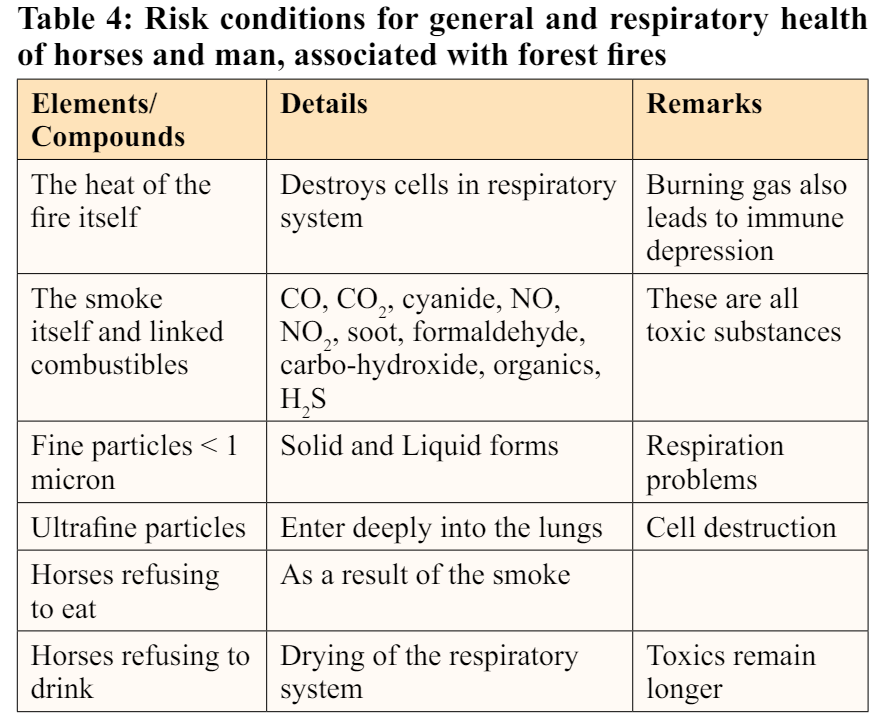
Table 5 presents the effects of smoke in horse and man. These effects are comparable to those listed in Table 2 for an impaired basic respiratory health. Smoke and its composition are major risk conditions for an impaired (respiratory) health in horse and man.
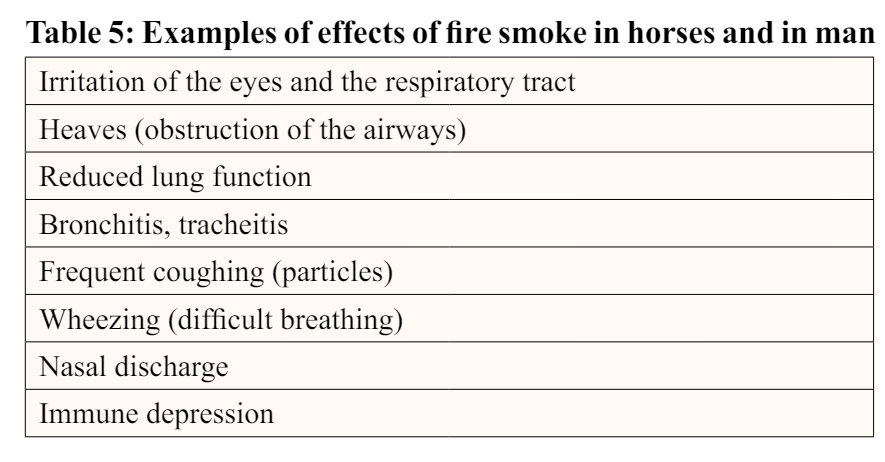
Depending on the severity of exposure to forest fire consequences, in particular smoke, the prognosis of recovery will vary [5].
For example, after a light exposure the recovery may be between roughly two and four weeks for a horse. When a more chronic affection has been established due to severe exposure, with particles entered deeply in the lungs, the recovery, if any, may be up to six weeks or even months; some of these horses develop a chronic asthma. The half-life of deep particles is around 90 days [5, 11].
Effects of immune depression become manifest much later, while the long-term effects of exposure have not been studied in detail and, hence, are not predictable at all.
The question ‘’when can a person or a horse retake exercise, training, or competition after an exposure to smoke?’’ is very hard to answer. The individual sensitivity and resistance vary greatly between individuals.
In man, several medical interventions are proposed such as oxygen provision, methylene blue, thiosulfate and sodium nitrate, bronchodilators, nebulized albuterol. An overview of these can be found in [8, 10, 12]. Such products are commonly not used in horses.
Pinkerton stated in 2022 that ‘’horses might be sentinels for the effects of forest fires and air pollution in man due to their respiratory sensitivity’’ [13]. Under normal conditions, horses can clean out pollen and dust from their respiratory tract daily and within 24 hours. This process is largely impaired when forest fires occur, and horses are impacted.
Effects of heat stress in horses are a good example of an impaired respiratory health and decreased performance [6]. Heat stress is a severe negative contributing factor to aggravated loss of respiratory health. Moreover, heat stress effects occur in the same season as forest fires.
Despite the biological differences between man and horse, comparisons related to the effects of forest fires on man and horse are possible as is shown in the text.
One great difference between horses and man is the fact that many studies have been done on the sensitivity of man and on the effects of forest fires (smoke, particles) in man, while in horses such studies are hardly conducted if any, nor reported in literature. Another issue is that medical treatment in horses under forest fires is not a common procedure. Finally, protocols for ‘preparing for a forest fire season’ and ‘what to do during a forest fire’ exist for man, not for horses [10, 12]. The horse domain in general, and more specifically the top sporting horse domain, can learn from the studies in man.
